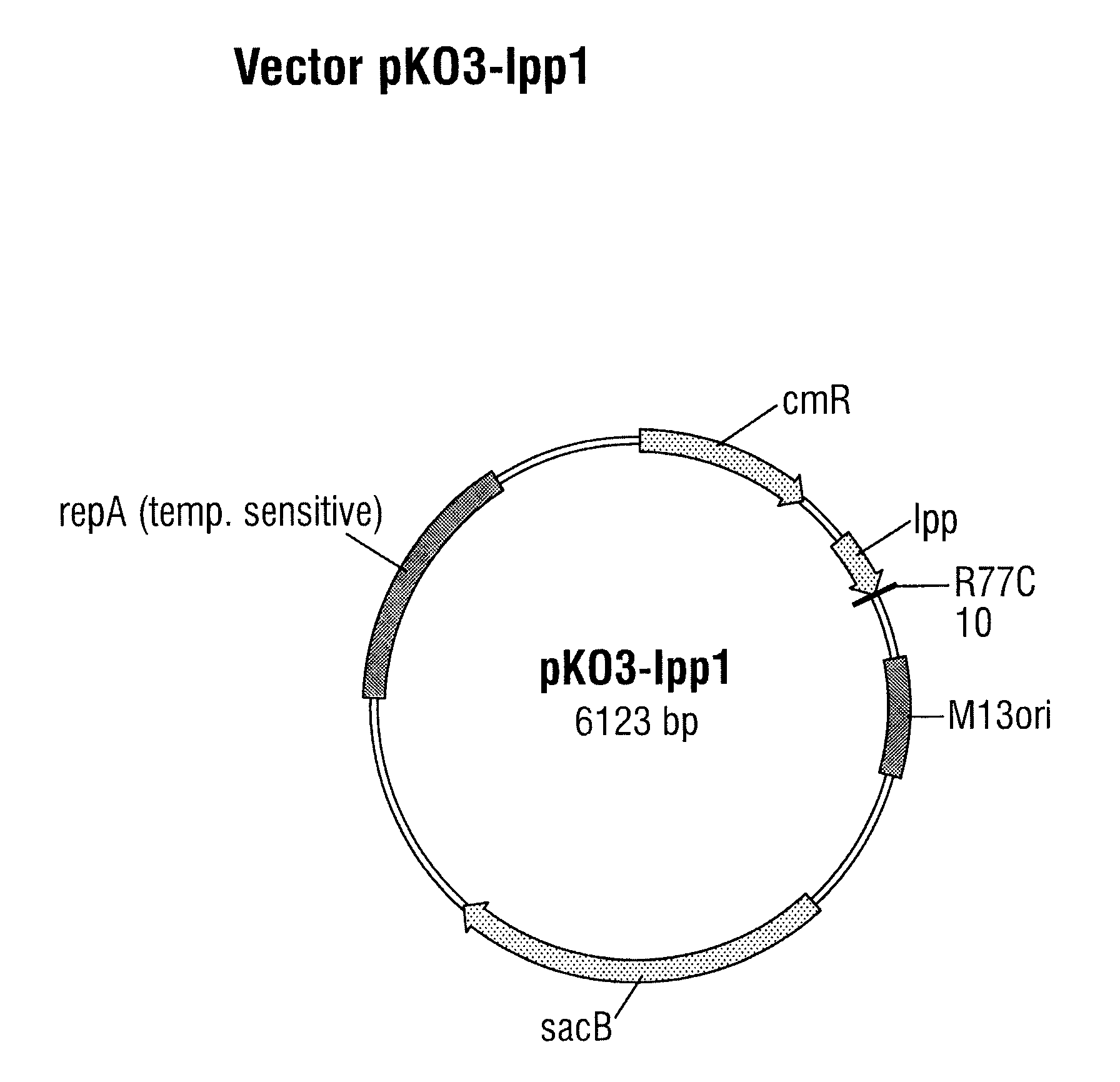Process for the fermentative production of proteins
a technology of protein and process, applied in the field of process for the production of heterologous proteins, can solve the problems of complex production procedure through mutagenesis and screening, low protein yield achieved in the medium with such strains, and unwanted mutations
- Summary
- Abstract
- Description
- Claims
- Application Information
AI Technical Summary
Benefits of technology
Problems solved by technology
Method used
Image
Examples
example 1
[0102]Generation of a Chromosomal lpp Deletion Mutant From a Wild-type E. coli Strain
[0103]The procedure for generating an lpp deletion mutant of the wild-type E. coli strain W3110 (American Type Culture Collection (ATCC): 27325) with the aid of λ recombinase was according to the method of Datsenko and Wanner (2000, Proc. Natl. Acad. Sci. USA. 97: 6640-5). This entailed initially generating, with the aid of the polymerase chain reaction (PCR) using the oligonucleotides lpp1 (SEQ ID NO: 4) and lpp2 (SEQ ID NO: 5) as primers and the plasmid pKD3 (Coli Genetic Stock Center (CGSC): 7631) as template, a linear DNA fragment which comprises a chloramphenicol resistance gene and which is flanked by in each case 50 base pairs of the upstream region and of the downstream region of the lpp gene.
[0104]The strain W3110 was firstly transformed with the plasmid pKD46 (CGSC: 7739). Competent cells of the strain W3110 pKD46 obtained in this way, which had been produced in accordance with the stateme...
example 2
[0106]Generation of a Chromosomal lpp1 Mutant From a Wild-type E. coli Strain
[0107]Replacement of the wild-type lpp gene in the chromosome of the strain W3110 by the lpp1 allele took place by homologous recombination. The procedure for this was as follows:
[0108]A DNA molecule which contains the lpp1 allele and about 200 base pairs of the DNA region located on the 3′ side of the wild-type lpp gene (SEQ ID NO: 8) were produced by gene synthesis. This DNA molecule also has at each of the two ends a cleavage site for the restriction enzyme BamHI. The lpp1 allele includes bases 9 to 245 of SEQ ID NO: 8. The lpp1 allele differs from the wild-type lpp gene (SEQ ID NO: 1) by having a base substitution at position 229 (C to T) of the lpp gene, leading to replacement of the arginine residue at position 77 by a cysteine residue in the unprocessed Lpp protein.
[0109]The DNA molecule generated by gene synthesis and having SEQ ID NO: 8 was cut completely with the restriction enzyme BamHI. The clon...
example 3
[0111]Generation of a Chromosomal lpp3 Mutant From a Wild-type E. coli Strain
[0112]The procedure for generating a chromosomal lpp3 mutant of W3110 which, like the lpp1 mutant, has only one point mutation in the lpp gene was analogous to Example 2, with the difference that a DNA molecule with SEQ ID NO: 9, which was likewise produced by gene synthesis, was used instead of the DNA fragment with SEQ ID NO: 8. This DNA molecule comprises the lpp3 allele (bases 211 to 447) and about 200 base pairs of the DNA region located on the 5′ side of the wild-type lpp gene. This DNA molecule additionally has at each of the two ends a cleavage site for the restriction enzyme BamHI. The lpp3 allele differs from SEQ ID NO: 1 by having a base substitution at position 41 (G to A) of the lpp gene, leading to replacement of the glycine residue at position 14 by an aspartic acid residue in the as yet unprocessed Lpp protein.
[0113]The plasmid pKO3-lpp3 (FIG. 2) generated by ligation of the respectively Bam...
PUM
| Property | Measurement | Unit |
|---|---|---|
| concentration | aaaaa | aaaaa |
| concentration | aaaaa | aaaaa |
| volume | aaaaa | aaaaa |
Abstract
Description
Claims
Application Information
 Login to View More
Login to View More - R&D
- Intellectual Property
- Life Sciences
- Materials
- Tech Scout
- Unparalleled Data Quality
- Higher Quality Content
- 60% Fewer Hallucinations
Browse by: Latest US Patents, China's latest patents, Technical Efficacy Thesaurus, Application Domain, Technology Topic, Popular Technical Reports.
© 2025 PatSnap. All rights reserved.Legal|Privacy policy|Modern Slavery Act Transparency Statement|Sitemap|About US| Contact US: help@patsnap.com



